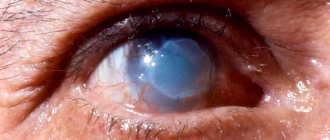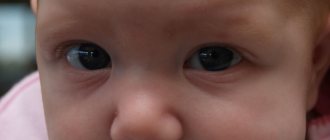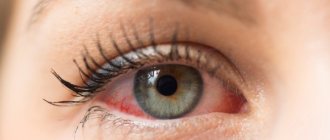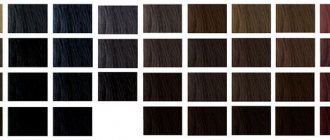About the drug
The drug has become widely known in ophthalmology due to its ability to destroy pathogenic microflora. Levomekol is a combination ointment consisting of chloramphenicol, an antibiotic, and methyluracil, an immunostimulating substance.
The drug is effective against most strains that cannot be treated with antibiotics. Levomekol has a positive effect on the conjunctiva of the eye. Ointment:
- stimulates protective properties;
- relieves burning and pain;
- destroys pathogenic microorganisms;
- activates metabolic processes;
- accelerates healing;
- stimulates tissues to repair themselves.
In 95% of cases, the cause of barley is Staphylococcus aureus, against which Levomekol ointment is most effective. The antimicrobial effect is due to chloramphenicol.
Overdose and side effects
Sometimes after applying the drug, a burning sensation is felt in the visual organ.
During treatment, Levomekol eye ointment may cause slight discomfort in the area of application. Burning and itching may occur. If the discomfort is not an allergic reaction, then treatment is not stopped. But it is important to tell your ophthalmologist about the discomfort. An ophthalmologist can prescribe an analogue remedy that will not cause discomfort. Blurred vision may occur immediately after the medication is injected into the eyes. Therefore, it is worth avoiding movement in the first half hour after administering the medicine to avoid injury.
There have been no cases of overdose of the surface agent "Levomekol", but the norms recommended by the attending physician should not be exceeded.
Indications for use
Levomekol is allowed to be used in other clinical situations. In addition to its use for hordeolum, it is prescribed for the treatment of other pathologies.
These include:
- 2nd and 3rd degree burns;
- trophic ulcers;
- boils and other purulent skin pathologies;
- sinusitis;
- ear infection;
- haemorrhoids;
- skin rashes;
- swelling.
The drug is prescribed for rapid healing of postpartum sutures and for postoperative complications. It is recommended to use for the speedy healing of herpes ulcers.
Also prescribed to patients with balanoposthitis, cystitis, lymphadenitis. Women use Levomekol in the presence of cracks and tears during the postpartum period. It is also prescribed by dentists to eliminate inflammation in the oral cavity.
How to use Levomekol for barley?
For each individual case, Levomekol is used differently. For example, large inflamed areas are treated with ointment in the form of compresses (the product is applied to a bandage that is applied to the damaged area), deep wounds require the drug to be applied into the lesions using a syringe, and small cuts and ulcers can be treated pointwise.
As for barley, the use of Levomekol for such inflammation is allowed only on the recommendation of a doctor. Self-use of the drug may be unjustified, and as a result you may harm your health. In addition, this ointment is not a special remedy against barley; it only has some features to relieve inflammation and destroy bacteria.
If you are prescribed ointments for the treatment of stye, they should be applied with a sterile cotton swab or swab, collecting a small amount of the drug on it. For superficial inflammations, “Levomekol” is applied to the swollen area, slightly covering its edges. Important: be sure to ensure that the drug does not get into the eye, as this can cause damage to its membrane. To eliminate internal styes, the ointment should be placed behind the eyelid, first pulling it away from the eye. This procedure is best performed at night, since the film formed by the ointment makes vision difficult.
The main component of Levomekol is chloramphenicol, which is also sold in the form of drops. This liquid product is often used to treat inflammation and mechanical damage to the eyes. On the first day of treatment, drops are instilled into the conjunctival eye sac, 1 drop every 1-2 hours, then the interval can be increased to 3-4 hours.
Remember that Levomekol, for all its effectiveness and rapid action, has some negative features - it is addictive with frequent use, and can also become the root cause of allergic reactions, so you should not use it on your own initiative, without a doctor’s recommendation.
Instructions for use
The method of using the medicine depends on the nature of the damage to the eyelid. Before use, wash your hands with soap and prepare a clean gauze bandage.
Mode of application:
- For external styes, apply with your finger or a cotton swab to the damaged area. The layer is small. Cover the eye with a gauze bandage to prevent dust from entering.
- For the internal form of the disease, the medicine is applied internally. Use your hands or a cotton ball to pull back the eyelid and apply a thin strip to the affected area. Close your eyes and move your pupils. Lightly massage with a cotton ball so that the ointment is evenly distributed. Unpleasant sensations will appear, the ointment will spread and form a protective film.
Levomekol is recommended to be combined with drops. The use of drops is allowed 15 minutes after using the ointment.
Apply until the purulent contents are completely released and then for some more time to speed up tissue healing.
It is possible to administer the drug into purulent cavities through a catheter using a syringe. Doctors perform the procedure by preheating Levomekol to 35 degrees.
Gels and other ointments for barley for children
To treat children's stye on the eye, it is recommended to use the following ointments and gels:
Oxolinic ointment
The medicinal substance is oxolin. It has antiviral and antibacterial effects. As a rule, this medicinal product is used to treat influenza and herpes, herpes zoster and scaly lichen, and Dühring's dermatitis herpetiformis. But, as practice shows, the ointment is very effective if it is used to treat children’s barley. Moreover, it can be used even for infants.
Phloxal
The medicinal substance is ofloxacin, which has antibiotic and bactericidal effects.
This German remedy can be used by children from 1 year of age. The manufacturer recommends applying it in a strip of up to 1 cm on the eyelid 3 times a day.
Can be used with other ophthalmic medications, primarily with eye drops. But, firstly, the interval between taking these drugs should be at least 15 minutes, and secondly, Floxal should be applied last.
Acyclovir
The therapeutic substance is acyclovir, which has antiviral and immunostimulating effects and is a synthetic analogue of thymidine nucleoside, a natural component of DNA.
Acyclovir has high selectivity of action and low toxicity. It inhibits (suppresses) the synthesis of pathogenic bacteria by three mechanisms:
- Inhibition of the bacterial polymerase enzyme.
- Incorporation into the synthesized DNA chain, which leads to the cessation of its growth.
- Replaces deoxyguanosine triphosphate in the process of DNA synthesis, which leads to a fatal disruption of the cell division process.
Acyclovir ointment has no contraindications for its use by children, including those under three years of age.
Please note that this medicinal drug should be taken only as directed by a doctor, after accurately determining the nature of the disease. The fact is that barley on the eye is caused by Staphylococcus aureus only in 90-95% of cases. In other cases, this disease is viral in nature. And in this rare case, Acyclovir is the most effective drug.
Erythromycin ointment
The medicinal substance is erythromycin, which has bactericidal properties.
In case of illness, it is recommended to apply the medicinal drug to the site of inflammation 3 times a day daily.
In case of local allergic reactions - itching or swelling of the eyelids - the use of the drug must be discontinued. There are no contraindications to erythromycin ointment if it is used to treat barley. But the course of treatment for children under 3 years of age should be carried out under the supervision of a pediatrician.
Syntomycin ointment
The drug substance is synthomycin (trade name for the powerful antibiotic chloramphenicol).
When the drug is applied to an inflammatory focus, synthomycin disrupts protein synthesis in Staphylococcus iris bacteria and destroys plasma membranes, which leads to severe inhibition of growth and then their death.
The ointment is contraindicated if the body is individually intolerant to syntomycin or the auxiliary components of the ointment (castor oil, sorbic acid, etc.). It is contraindicated to take this drug for psoriasis, eczema and fungal skin diseases.
There are no age restrictions for syntomycin ointment, but it is recommended to use it for the treatment of barley in children under 3 years of age under the supervision of a pediatrician.
special instructions
When the ointment is used internally, a film is formed that makes vision difficult. Driving vehicles and operating dangerous machinery should be excluded. The drug is not prescribed in conjunction with other external agents.
Antiseptic, antibacterial and anti-inflammatory drops are allowed.
When working with medicine, it is important to follow the rules of personal hygiene and safety precautions provided for when working with medicines.
When using ointment during pregnancy, one should take into account the possibility of absorption of the drug and its toxic effect on the body.
Levomekol ointment: properties and indications
The drug has a wide range of bactericidal effects. Eye ointment accelerates the recovery process of affected cells. The medicine strengthens the immune abilities in the affected area and helps eliminate local inflammatory processes. The surface agent activates the formation of leukocytes and unites them in the area of influence.
Doctors recommend this combination drug when the eyes are affected by a bacterial infection or inflammatory processes or suppuration have begun in the area of the organs of the visual system. Levomekol ointment is also used to treat sutures near the eyes; it is used for preventive purposes during the postoperative period. Often the medication is prescribed for the treatment of pathological processes such as:
- keratitis;
- keratoconjunctivitis;
- conjunctivitis due to eye infection;
- stage 2 and 3 burns;
- blepharitis;
- purulent-inflammatory lesions.
Return to contents
Instructions for use
Before medical manipulation, you must thoroughly wash your hands and spray them with disinfectant. Ophthalmologists often prescribe the application of compresses at the site of tissue damage. Instructions for use suggest applying the ointment to the area of the conjunctival sac. A dispensing nozzle is used for this. With its help, a 5 or 10 mm strip is inserted into the conjunctival area. During application, the tip must not get into the eye, as this can damage the tissue of the organ. After the procedure, it is important to treat the dispenser nozzle with a disinfectant. Sometimes, to obtain an optimal therapeutic result, it is allowed to inject Levomekol ointment, heated to 36 degrees, into the abscess cavity. This manipulation should be carried out by an ophthalmologist or nurse so that the process takes place without damage to the eye structures and to speed up recovery. For burns near the eye, the area of injury should be smeared.
Analogs
Levomekol has not lost its popularity in the ophthalmological field for a long time.
A substitute is prescribed in the absence of a positive result, the presence of side effects or contraindications.
Analogues:
- Acyclovir is used daily at intervals of 3–4 hours. Demonstrates a pronounced antiviral effect. The medicine prevents complications and eliminates the inflammatory process. Can be used simultaneously with Levomekol in tablet form.
- Vishnevsky's liniment is effective against hordeolum. It has an antibacterial, anti-inflammatory, absorbable effect and accelerates regeneration processes.
- Ichthyol ointment is not an independent medicine. Recommended for use in combination with antibiotics, such as drops.
- Erythromycin ointment has an anti-inflammatory and antimicrobial effect. Use the medicine 3 times a day; in the presence of purulent contents, use up to 5 times. Do not use if you have impaired liver function or hypersensitivity to the drug.
- Tetracycline ointment is prescribed for infectious and inflammatory pathologies. The medication is applied to the affected eyelid until the inflammation subsides and heals completely. Tetracycline is prohibited for use during lactation, children under 5 years of age, pregnancy and fungal eye infections.
- Levosin has a similar composition. The combined product kills bacteria, relieves inflammation, relieves pain and heals. Levosin is used to impregnate sterile gauze dressings that are applied to the sore eye. It is possible to administer it through a drainage tube directly into the purulent focus. The procedure is performed in a hospital, after which the patient must be under the supervision of medical staff.
- Netran acts similarly to Levomekol and Levosin. Indications and contraindications are the same. Can be injected into a purulent focus.
You cannot replace the drug yourself. The doctor selects the analogue, prescribes the dosage and duration of therapy.
What to replace it with?
If excessive discomfort occurs while using the drug "Levomekol", doctors may prescribe an analogue. Before taking other medications, it is important to take into account individual sensitivity to the substances in the composition. It is also important to pay attention to the relationship of the drug during complex treatment in order to exclude unwanted reactions or lack of therapeutic effect. In case of inflammatory processes, ophthalmologists can recommend calendula ointment, and in case of eye damage from a bacterial infection, antibiotics are prescribed - Levomycetin drops, Albucid solution or Tobrex emulsion.
Reviews
Marina Shcherbina: I often used it for myself and children to heal wounds. I tried it against barley for the first time and was pleased. Used simultaneously with antibacterial drops for a week. Now this is my lifesaver against any infectious and inflammatory problems.
Evgeniy Viktorovich: I’ve been using it for many years. Levomekol is a magic ointment. Helps with purulent wounds and has already saved me from stye on the upper eyelid three times. My daughter used it while breastfeeding, it did not affect lactation in any way.
Causes of stye on the eye
The appearance of stye on the eye causes inflammation of the sebaceous gland, ciliary hair follicle or disease of the eyelid, lobules of the meibomian gland. Barley or Gordeolum can be internal or external, located on the outer or inner part of the eyelid.
In 95% of cases of the disease, the culprit is Staphylococcus aureus and at the same time weakened immunity. Among other associated causes, it is necessary to note diseases of the gastrointestinal tract, endocrine system, vitamin deficiency, and hypothermia.
The disease is not considered contagious.










